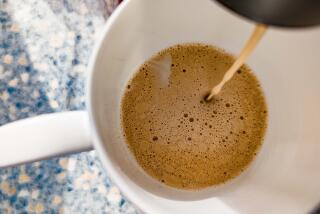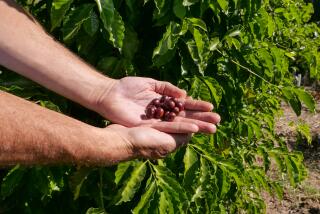Coffee Is These Tasters’ Cup of Tea : Professional Graders Decide the Fate of Imported Beans
NEW YORK — In a small corner room at the World Trade Center, an elite group of people with gifted taste buds, speedy slurps and an appreciation of caffeine gather for a special mission: to decide the fate of billions of beans.
Equipped with cups, silver spittoons and freshly roasted brew that would shame any doughnut shop, the tasters judge whether coffee grown in 46 countries meets the standards of the New York Coffee, Sugar & Cocoa Exchange.
It’s a job that has become more important because of the suspension of coffee export limits this summer, which resulted in a flood of beans pouring into the United States, the world’s biggest coffee market.
Rejection could mean huge losses for importers and brokers, particularly now that producers can’t rely on the agreement to sell their coffee beans and therefore must compete on quality.
Though the rejected coffee isn’t discarded, it may sit longer in a warehouse, could be sold at a discount or end up as a roasted blend or generic-brand instant, the coffee equivalent of an old horse sent to the glue factory.
On this particular day, about $2 million worth of coffee--or nearly 2.5 million pounds--is at stake. But there were periods in the past two years when all was quiet in what’s known in coffee parlance as “the grading room.”
“There was absolutely nothing going on for four to five months, nothing, zero,” says Glenn Garnes, grading room assistant at the exchange where coffee, sugar and cocoa contracts are traded.
Bypassed Exchange
Coffee sold quickly in those days because of export quotas set by the International Coffee Organization, the cartel of producers that artificially determined prices through limiting the supply.
Tight supplies and high demand meant that a lot of coffee bypassed the exchange and went directly to brokers or roasters.
With more beans to judge these days the tasters must slurp more mouthfuls of coffee. Since they’re paid by the number of bags tested, their take has increased to about $630 for nearly two hours’ work, which amounts to more than $12 a slurp. During normal periods they earn about $200.
On July 4, the ICO temporarily suspended export ceilings that had kept wholesale prices at between $1.20 and $1.40 a pound. U.S. roasters had criticized the quotas for limiting access to quality coffee.
With coffee pouring into the United States, prices have tumbled nearly 40% and made it a buyers’ market.
Further depressing prices is the normal slow summer roasting period, a long-term decline in U.S. coffee consumption and efforts by producers to empty warehouses before the new harvest starting in September.
“If the market is already at these levels in anticipation of new crops what will happen when the new crop actually comes?,” says Bert Ruiz, industry analyst with the New York brokerage firm Balfour Maclaine Corp.
Prices Dropping
Retail prices also have fallen. Two of the biggest roasters, General Foods Corp. and Procter & Gamble Co., which have about 65% of the U.S. coffee market, announced big price cuts Aug. 7.
General Foods, which markets Maxwell House and Sanka coffees, said it dropped the average price it charges retailers 23 cents a pound for ground roasted coffee. Procter & Gamble, marketer of Folgers, lowered its price by 20 cents to about $2.50 a pound.
There’s not much talking in the grading room as the testers judge the coffee first by color and grade, or purity. Working in teams of three, they sort through pans of small green coffee beans for imperfections--brown, black, rotten or faded beans.
Dirt and other impurities count against the batch. Every five bad beans, or one black bean, equals one imperfection. Fifteen imperfections disqualifies the entire lot.
Color also is important because as coffee ages it loses moisture and fades, says taster Steve Colten, quality control manager for J. Aron & Co. coffee importers. Colten and the 26 other graders, including two women recently added to the erstwhile male group, leave jobs or other activities to grade coffee.
Each pan, representing one 37,500-pound lot, is numbered so that the testers know only the country of origin.
“We work blind so nothing biases our opinion,” says Bill Griffin, former senior buyer for Nestle Foods Corp.
Knowing the country is important because shades of color differ as do acidity and flavor, tasters say. Coffees with earthy, fermented characteristics passable for one country’s coffees wouldn’t be for another.
A tantalizing aroma fills the room as the beans are thrown into old-fashioned roasters for browning over an open flame. The beans are then ground and steeped in boiling water in preparation for tasting, the ultimate proving ground.
With a loud slurp Ray Schlegelmilch sucks in a spoonful of brew, twirls it around his tongue and spits into a silver spittoon near his feet. Quickly adjusting the swivel-top table, he brings the next cup into position, breaks through the film of grounds atop the liquid, scoops another mouthful and repeats the ritual. In a matter of seconds, he has tasted 21 cups.
Body, the right twinge of acidity and a good “bouquet” or aroma are important. But tasters look for “negative rather than positive characteristics,” says Justin Colten, a former executive with J. Aron, who believes that coffee tasting is “a very unique art.”
Anything “off odor,”--a dirty or musty smell--or that tastes too acidic, leathery, fermented, medicinal or earthy is rejected.
This day, a Mexican coffee that has already passed color and grade tests is rejected on taste. Garnes calls the importer, who requests a second opinion. Three more tasters are asked to judge the brew. It passes on second tasting.
The testers, all current or retired coffee-industry executives, are purists about coffee outside the grading room, too. Some are so choosy that they won’t buy coffee already roasted, much less ground. Several buy raw beans and roast them at home.
“Anyone in the coffee business is very picky about their coffee,” says Steve Colten.
As for the latest fad--flavored coffee, which is marinated in liquid flavorings ranging from cinnamon to coconut--the tasters turn up their noses.
“It’s adulterated,” says one.
“No one grows cinnamon-nut flavored coffee,” says another. “If you get a good cup of coffee, you don’t need flavorings. You don’t even need cream or sugar.”
More to Read
Eat your way across L.A.
Get our weekly Tasting Notes newsletter for reviews, news and more.
You may occasionally receive promotional content from the Los Angeles Times.









